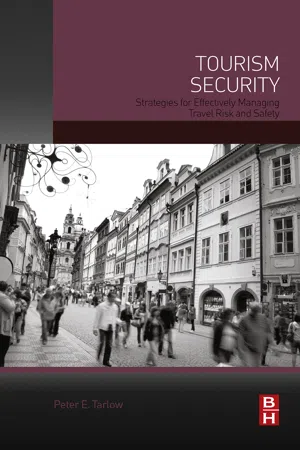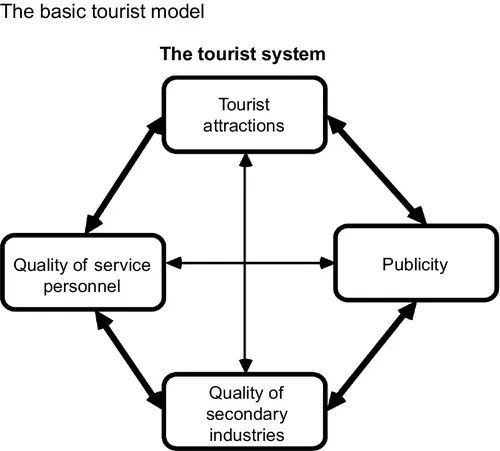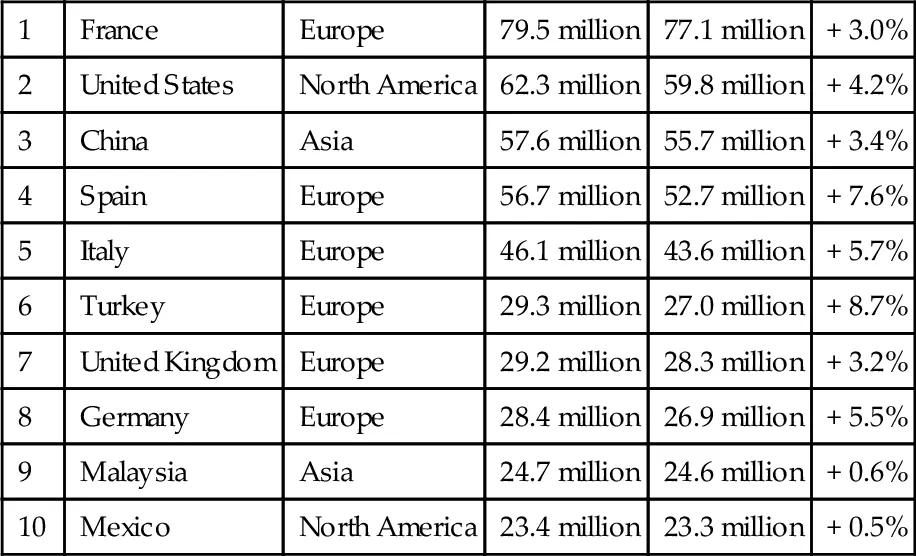
- 312 pages
- English
- ePUB (mobile friendly)
- Available on iOS & Android
eBook - ePub
About this book
Tourism security is an important part of both security management and tourism. Private security professionals and police departments in tourism cities, as well as hotels, major attractions, and theme parks, have all come to realize that tourism security and safety issues (often called tourism surety) are essential for industry survival and success. In Tourism Security, leading expert Peter Tarlow addresses a range of key issues in tourism safety and security.The book guides the reader through a study of tourism security themes and best practices. Topics include the relationship between tourism security and the economy, hotel and motel security, risk and crisis management, public places, transportation, and legal issues. The book also includes case studies of four popular tourist destinations. With each destination, an interview with a police or security representative is included—providing unique, in-depth insight to security concerns.Tourism Security is an invaluable resource for private security professionals, police departments that serve tourist destinations, and tourism professionals who work in hotels or convention centers, or at attractions, casinos, or events.
- Explains what tourism security is and outlines safety procedures for different tourism environments
- Serves as a resource tool and how-to for implementing best practices
- Includes detailed case studies of four popular tourist destinations: Charleston, South Carolina, the Dominican Republic, Las Vegas, Nevada, and Rio de Janeiro, Brazil
Frequently asked questions
Yes, you can cancel anytime from the Subscription tab in your account settings on the Perlego website. Your subscription will stay active until the end of your current billing period. Learn how to cancel your subscription.
At the moment all of our mobile-responsive ePub books are available to download via the app. Most of our PDFs are also available to download and we're working on making the final remaining ones downloadable now. Learn more here.
Perlego offers two plans: Essential and Complete
- Essential is ideal for learners and professionals who enjoy exploring a wide range of subjects. Access the Essential Library with 800,000+ trusted titles and best-sellers across business, personal growth, and the humanities. Includes unlimited reading time and Standard Read Aloud voice.
- Complete: Perfect for advanced learners and researchers needing full, unrestricted access. Unlock 1.4M+ books across hundreds of subjects, including academic and specialized titles. The Complete Plan also includes advanced features like Premium Read Aloud and Research Assistant.
We are an online textbook subscription service, where you can get access to an entire online library for less than the price of a single book per month. With over 1 million books across 1000+ topics, we’ve got you covered! Learn more here.
Look out for the read-aloud symbol on your next book to see if you can listen to it. The read-aloud tool reads text aloud for you, highlighting the text as it is being read. You can pause it, speed it up and slow it down. Learn more here.
Yes! You can use the Perlego app on both iOS or Android devices to read anytime, anywhere — even offline. Perfect for commutes or when you’re on the go.
Please note we cannot support devices running on iOS 13 and Android 7 or earlier. Learn more about using the app.
Please note we cannot support devices running on iOS 13 and Android 7 or earlier. Learn more about using the app.
Yes, you can access Tourism Security by Peter Tarlow in PDF and/or ePUB format, as well as other popular books in Business & Information Management. We have over one million books available in our catalogue for you to explore.
Information
Chapter 1
Introduction to Tourism Security
Abstract
This chapter provides an introduction to tourism security and how it relates to the general world of tourism. The chapter provides us with a historic overview of how tourism viewed security both before and after September 11, 2001. It also focuses on issues of safety, security, and surety. The chapter begins with an examination of the role of perceptions in tourism security, and then it provides a sociological analysis of how tourism security interacts with travelers. This chapter provides an overview of the types of tourism security and why the field is much more complex than what most laypeople assume.
Keywords
Perceptions
Safety
Security
Soft uniforms
Surety
Tourists
Travelers
Visitors
The Tourism Phenomenon
Modern tourism is the world’s largest peacetime industry, yet it often remains an enigma, not only to tourism scholars and professionals but also to those who are tasked with protecting visitors and the tourism industry. Tourism is something that everyone recognizes, but almost no one can define. There are almost as many explanations as to what tourism is as there are tourists.
While there may be scholarly debates over tourism’s precise definition, there are still many areas of agreement. For example, most scholars will attest to the fact that tourism is about unique perceived experiences.
• Emotions are not necessarily connected to educational levels.
• Often, the higher the level of scientific reasoning within a society, then the more prone that society’s members are to periods of irrational thought.
• In tourism, fantasy and reality may merge into a world of simulata. Simulata is the reproduction of reality in such a way that it mimics reality without being reality. A good example of simulata is the movie Argo, which is a movie about a movie.
• Security and safety have as much to do with our perceptions of them as they have to do with concrete data.
If we look at the United States, then we can note both facts and interpretations of facts. According to the World Tourism Organization (WTO), the United States ranked second in tourism arrivals with 62.3 million; France ranked first with 79.5 million arrivals (International Tourism & Number of Arrivals, 2013). However, if a person from, to use the Russian term, “the near abroad” chooses to use a French airport, is that person a tourist? Should a person who arrives at one Paris airport, and a few hours later leaves from another Paris airport, be considered a tourist? Do we define that person as a transient or a visitor?
Despite these statistical challenges, tourism is big business. In every U.S. state, tourism is either the largest or the second- or third-largest industry. If we assume that an export item is defined as “bringing money from place X to place Y,” then tourism is also a major export item. Internationally, the tourism industry brings in millions of dollars, and it is one of the major job providers in many nations (Table 1.1).
Table 1.1
International Tourist Arrivals
| 1 | France | Europe | 79.5 million | 77.1 million | + 3.0% |
| 2 | United States | North America | 62.3 million | 59.8 million | + 4.2% |
| 3 | China | Asia | 57.6 million | 55.7 million | + 3.4% |
| 4 | Spain | Europe | 56.7 million | 52.7 million | + 7.6% |
| 5 | Italy | Europe | 46.1 million | 43.6 million | + 5.7% |
| 6 | Turkey | Europe | 29.3 million | 27.0 million | + 8.7% |
| 7 | United Kingdom | Europe | 29.2 million | 28.3 million | + 3.2% |
| 8 | Germany | Europe | 28.4 million | 26.9 million | + 5.5% |
| 9 | Malaysia | Asia | 24.7 million | 24.6 million | + 0.6% |
| 10 | Mexico | North America | 23.4 million | 23.3 million | + 0.5% |
Source: 2013 tourism highlights (2013).
Data taken from the World Tourism Organization for 2011.
www.indexmundi.com/facts/indicators/ST.INT.ARVL/Ranking (November 2, 2013).
Note: Different nations and organizations use different statistical methods and definitions of a tourist or tourist year, thus there will be slight variations in the numbers.
Tourism Terminology and History
The most common term employed among the industry’s professionals is “travel and tourism.” They use this term as if it were one word. Travel and tourism, however, are different from one another. Travel is one of the world’s oldest phenomena. In a sense we can trace it back to the beginnings of recorded history. Humans, just as other species, have consistently wandered from place to place. Ancient men and women traveled to find food or escape danger, and they traveled due to harsh weather conditions or natural phenomena. Yet, few people saw travel as a pleasurable experience; in fact, travel was hard work. The entymology of the word travel reflects this difficulty. We derive the modern word travel from the French word travail, meaning “work,” while the French derive travail from the Latin word trepalium, meaning an “instrument of torture.”
For most of human history, travel was hard work and often torturous. Until the modern era (and even into the modern era), travelers never knew when weather conditions might turn “roads” into seas of mud. Robbers and kidnappers often ruled the nights, and pirates, stealing both goods and persons, were common fare. To add to travelers’ woes, places of lodging were often cold and uncomfortable, they rarely provided privacy, and their food was irregular in both quantity and quality.
Modern Tourism Definitions
“Modern tourism” is one of those terms that most people understand, yet few people define well. There seems to be no definitive definition for “tourism.” Tourism is defined as: “the practice of traveling for recreation; the guidance or management of tourists; the promotion and encouragement of touring; the accommodation of tourists” (Merriam-Webster’s Collegiate Dictionary, 1993, p. 1248). Other scholars and tourism scientists present alternative definitions. For example, in the preface to The Tourism System (1985), David Pattison, then head of the Scottish Tourism Board, writes: “From an image viewpoint, tourism is presently thought of in ambiguous terms. No definitions of tourism are universally accepted. There is a link between tourism, travel, recreation, and leisure, yet the link is fuzzy…” (p. xvi).
However, Goeldner and McIntosh (1990) define tourism as: “the science, art, and business of attracting and transporting visitors, accommodating them, and graciously catering to their needs and wants” (p. vii). Later on, however, they state: “Any attempt to define tourism and to describe fully its scope must consider the various groups that participate in and are affected by this industry” (p. 3). The authors then describe four different scopes of tourism: (1) persons traveling for pleasure, (2) persons traveling for meetings or to represent another, (3) persons traveling for business, and (4) cruise passengers on shore (p. 6). In fact, we can reduce McIntosh and Goeldner’s four categories into two, those traveling for pleasure or due to their own volition, and those traveling for commercial or business reasons.
On the other hand, Choy, Gee, and Makens (1989) in the work The Travel Industry define tourism by stating: “the travel industry will be defined as “the composite of organizations, both public and private, that are involved in the development, production, and marketing of products and services to serve the needs of travelers” (pp. 4–5) (Figure 1.1).

Figure 1.1 The tourism industry.
Lack of a Unified Vocabulary
A review of the literature demonstrates that there is no one definition for the term “tourism,” or any one single word to describe the industry. In the United States, travel or “travel and tourism” is the preferred colloquial, while in many other countries, the term “tourism” tends to dominate. Moreover, there is no set definition for the term “tourist” or how this phrase differs from others, such as visitor, or even day-tripper. For example, is a person who leaves his or her town to shop in a town nearby a tourist or a visitor? What if the same person stays in a taxable place of lodging? Are day-trippers tourists, visitors, or neither? What about cruise passengers who spend just a few hours in a port of call? What are they to be called?
For purposes of this book, a tourist is defined as someone who travels more than 100 miles (160 km) and stays at least one night in a taxable place of lodging or with family and friends. A visitor is defined as a person who earns his or her money in place X but spends it in pla...
Table of contents
- Cover image
- Title page
- Table of Contents
- Copyright
- Dedication
- Acknowledgments
- About the Author
- Foreword
- Foreword Two: Problems of Tourism Safety in Latin America
- Introduction
- Chapter 1: Introduction to Tourism Security
- Chapter 2: The Relationship between Tourism Security and the Economy
- Chapter 3: Hotel and Motel Security
- Chapter 4: Risk and Crisis Management
- Chapter 5: Public Gathering Places
- Chapter 6: Aquatic Tourism: Security at Beaches, Rivers, Lakes, and on the High Seas
- Chapter 7: Transportation: Travel by Air, Car, and Train
- Chapter 8: Tourism Security Legal Issues
- Chapter 9: Case Studies: Four Tourism Cities
- Afterword
- Index
